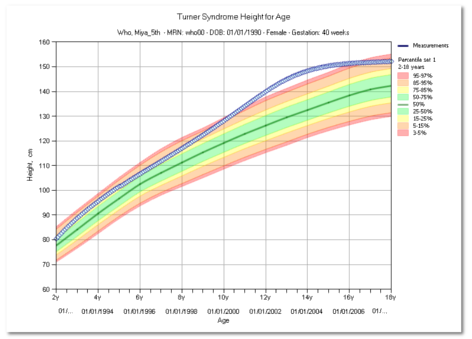Turner Syndrome Growth Charts TS affects approximately 1 out of every 2,500 female live births worldwide. It embraces a broad spectrum of features, from major heart defects to minor cosmetic issues. Some individuals with Turner syndrome may have only a few features, while others may have many.
Almost all individuals with Turner syndrome have short stature. This is partially due to the loss of one copy of the SHOX gene on the X-chromosome. This particular gene is important for long bone growth. Linear growth is attenuated in utero, and statural growth lags during childhood and adolescence, resulting in adult heights of 143-145 cm (approximately 4 feet 8 inches). Final adult height in Turner syndrome can be increased by a several inches if growth hormone (GH) treatment is given relatively early in childhood.

Latest Updates
- Jun 2025 - Spinal muscular atrophy (SMA) charts added
- Mar 2025 - Neonatal Blood Pressure Charts added
- Mar 2025 - Renal length growth charts
- Apr 2024 - Added CDC Extended BMI charts (2022)
- Apr 2024 - New account type for organizations with multiple sites
- Jul 2023 - Added neonatal charts for Premature and Very Premature infants (INTERGROWTH)
- Jul 2023 - Simple API for integration into EMR and patient portals released
- Jul 2023 - Mobile-friendly version released
- Jul 2023 - Added Weight Gain During Pregnancy charts (INTERGROWTH)
- Jul 2023 - New fetal chart for Symphysis-Fundal Height added
- Jul 2023 - Added Estimated Fetal Weight chart (Hadlock-2)
- Jul 2023 - New fetal chart for Umbilical Artery Pulsatility Index added
- Jul 2023 - New fetal chart for Umbilical Artery Systolic/Diastolic Ratio added
- Jul 2023 - New fetal chart for Umbilical Artery Resistance Index added
-
Feb 2022 - Keep track of Health Issues (icd10), Medications, Allergies and Notes on redesigned Summary screen.
-
Feb 2022 - Stronger security with two-factor authentication for professional accounts.
-
Feb 2022 - Added Height Velocity charts (Kelly, A. et al.).
-
Feb 2022 - Added Fitness charts: Eurofit, ALPHA Fitness Test Battery, Presidential Physical Fitness Award Program.
-
Feb 2022 - Sign in with Google or Facebook for family accounts.
-
Feb 2020 - Added charts for Rett syndrome.
-
Oct 2019 - Added charts for arm circumference, subscapular skinfold and triceps skinfold.
-
Sep 2019 - Added charts for weight gain during pregnancy.
-
Aug 2019 - New charts added for Osteogenesis Imperfecta.
-
Apr 2019 - Fetal growth standards from WHO, Intergrowth-21 and NICHD are added for professional accounts (for patients with Last Menstrual Period).
-
Dec 2018 - Added chart for tracking BMI in severely obese children (with percentages of the 95th percentile).
-
Nov 2018 - New look for better usability.
-
Aug 2018 - Reference WHO and CDC percentile lines for specialty charts.
-
May 2018 - New charts added for: DiGeorge (22q11.2 Deletion), Barth , Costello, Smith–Lemli–Opitz and Noonan syndromes and Majewski Osteodysplastic Primordial Dwarfism.
-
Sep 2017 - New Pediatric Blood Pressure charts are available on MyGrowthCharts.com. Read about them here:
Clinical Practice Guideline for Screening and Management of High Blood Pressure in Children and Adolescents.
-
Aug 2017 - Four methods of Midparental band calculations for Endocrinology charts: Midparental Percentile, Corrected Midparental Height (Tanner), Final Parental Height (Luo et al.) and SDS method (Hermanussen and Cole). Select in Settings.
-
Jul 2017 - New Chart Engine is released.

The most advanced software for capturing and charting measurements of height, weight, head circumference and BMI.
|
For Professionals
|
|
Features include Growth Velocity Calculator, Preterm Birth Auto-correction, Interactive Zoom In/Out, Printer Perfect Charts, Metric and English Units, Exact Percentiles and Z-Scores, Annotations, Neonatal charts and charts for Endocrinologists, Bone Age display etc.
|
|